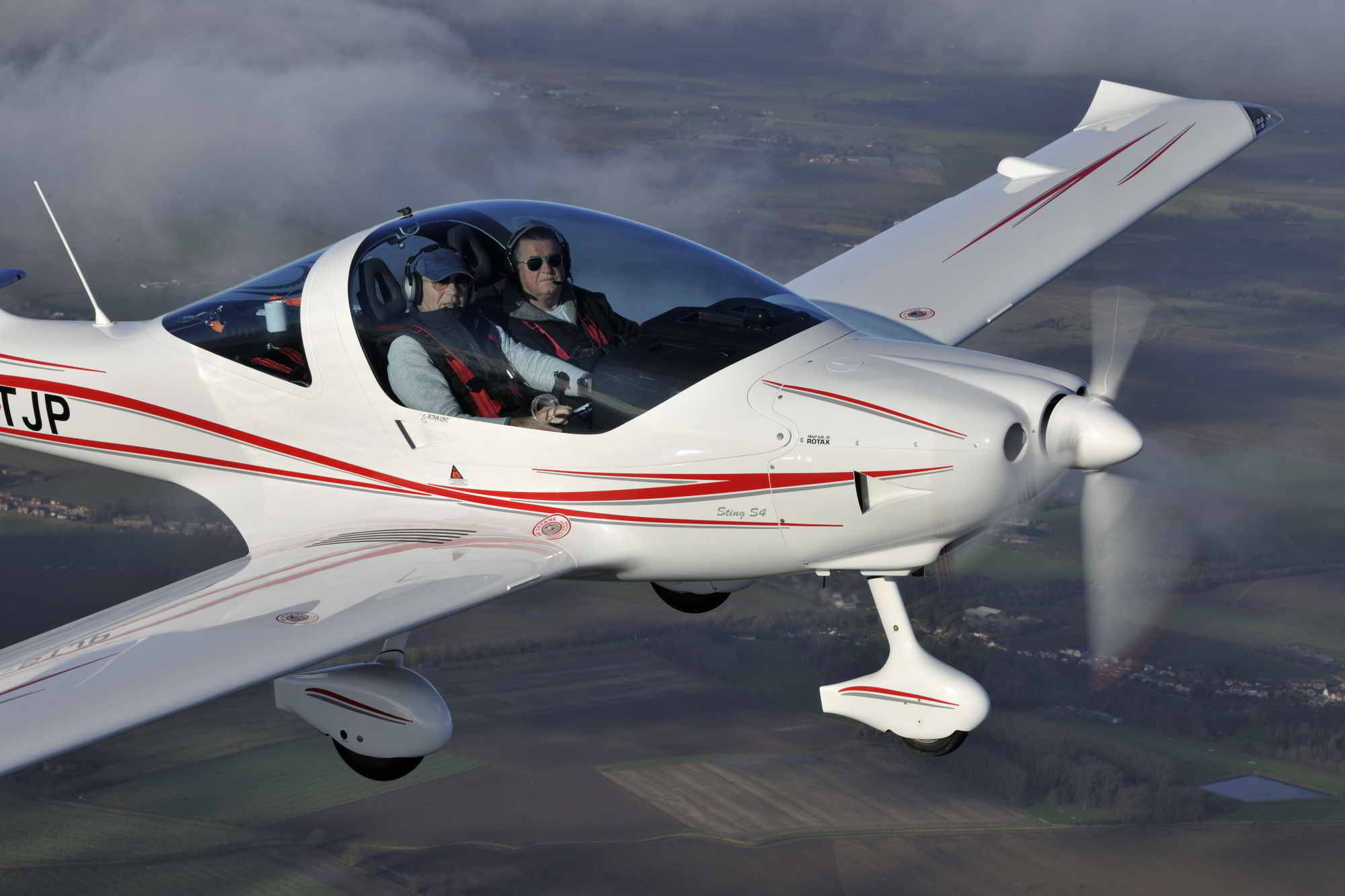 “Look at that groundspeed!” I exclaimed, pointing at the Garmin EFIS. “Our TAS is nearly 125 knots, which means we’ve got a 60 knot headwind straight on the spinner!” “Can you imagine being up here in a traditional microlight?” asked the Sting’s owner, John Palmer. “No, because not only would I be scared out of my mind at the prospect of having to land, but right now we’d practically be going backwards!” I said.
“Look at that groundspeed!” I exclaimed, pointing at the Garmin EFIS. “Our TAS is nearly 125 knots, which means we’ve got a 60 knot headwind straight on the spinner!” “Can you imagine being up here in a traditional microlight?” asked the Sting’s owner, John Palmer. “No, because not only would I be scared out of my mind at the prospect of having to land, but right now we’d practically be going backwards!” I said.
I’ve written before about just how capable and potent the new breed of light sport microlights is, and several of the aircraft I’ve tested recently are not only comparable to traditional GA types, but are demonstrably superior. An excellent representative of this new breed of speedy sport planes is the Sting S4, from Czech airframer TL Ultralights.
As I wait at Saltby for John to arrive in the Sting, I’m aware that it’s extremely windy, and that if I’d told someone that I was planning on flying a microlight in such conditions, they’d probably think I was mad—or suicidal. That’s because the traditional image of a microlight as little more than a hang glider powered by a lawnmower engine is still uppermost in many laypeople’s eyes, but as the Sting lands, it looks nothing like a microlight. It’s very much a light aircraft. Usually, I’d have a good look around the aircraft and then spend some time acquainting myself with the cockpit, but today we’re on a tight schedule, and I have flown a Sting before. About 10 years ago, admittedly, but I think I can hack the program. However, pride often comes before a fall (or on this occasion a call). More on this later.
So Let’s Fly
Having hurriedly strapped myself down with the excellent four-point harness (the seats are fixed, although the rudder pedals adjust) we start up, line up and go. With around 13 gallons of fuel and no baggage, our mass is quite close to the 1320-pound max takeoff weight. But we use less than 10% of the 3600-foot runway before I rotate at 50 knots and the Sting springs off the runway. It settles into a 65-knot climb with the VSI indicating just over 1000 fpm.
The flaps retract quickly with no discernible change in pitch, and I point the shapely spinner towards Fenland. It’s a Jekyll and Hyde day. Below the clouds it’s gray and bumpy, but above them it’s smooth and sunny, while the strong tailwind is giving us a very impressive groundspeed.
Fenland quickly appears, we can see the Cessna 172 photo ship climbing away right on schedule. I’m soon slotting the Sting neatly into echelon port. Photographer Keith Wilson opens his window, and we’re off.
Initially all goes well, but remember what I said earlier about pride coming before a call? The stick top is liberally studded with six switches and buttons, and while replying to C172 pilot Steve Brown, I accidentally changed frequencies! That minor SNAFU aside, this is a fun shoot. It’s nice and smooth above the clouds, with great visibility and beautiful light. Steve flies a smooth lead, and the fantastic field of view provided by the big bubble canopy, crisp handling and constant-speed prop ensure the shoot is completed quickly—which is just as well, as the wind has blown us almost to Norfolk.
As is often the case, the formation work has already told me what I need to know about the control response and harmony. They really are excellent, with authoritative ailerons, an effective elevator and influential rudder. The ailerons and elevator are actuated by pushrods—and you can tell. It’s very crisp in pitch and roll but not twitchy. It has the ideal blend of control and stability.
It’s maneuverable when you want it to be, and stable when you don’t, although I note an interesting anomaly. When turning tight to port, there’s a subtle but definite rumble through the stick.
Breakout forces are low, and the roll rate rapid, with a 45-45° reversal taking less than two seconds. There is negligible adverse yaw. The stick-free stability is exactly as I remember it, being a little weak directionally (in yaw), positive longitudinally and neutral laterally. The soft directional stability is typical of many light aircraft fitted with large nosewheel spats, as there’s often not a lot of side-area aft of the center of pressure.
Slowing down for some stalls reinforces that the Sting is as slippery as it looks, as it decelerates quite slowly even with the throttle at idle and the prop set fairly fine. All the stalls are very benign. With flaps up or down, throttle closed or wide open—there are no alarming attributes or unpleasant peculiarities, and to recover, just lower the nose and the wing begins flying again almost instantly, with minimal height loss. With the flaps down the deck angle is just preposterously precipitous. You’d have to be asleep to inadvertently stall it.
At such high angles of attack, position error makes the ASI unreliable, but the book speed of 43 knots IAS seems perfectly plausible. However—and again this is a trait it shares with many similar types, the flap-extension speed is quite low at only 65 knots. On a day with any real wind, 60 knots is a sensible speed on final, and if you decide to go around, you need to pitch up and reconfigure quickly to avoid busting the Vfe.
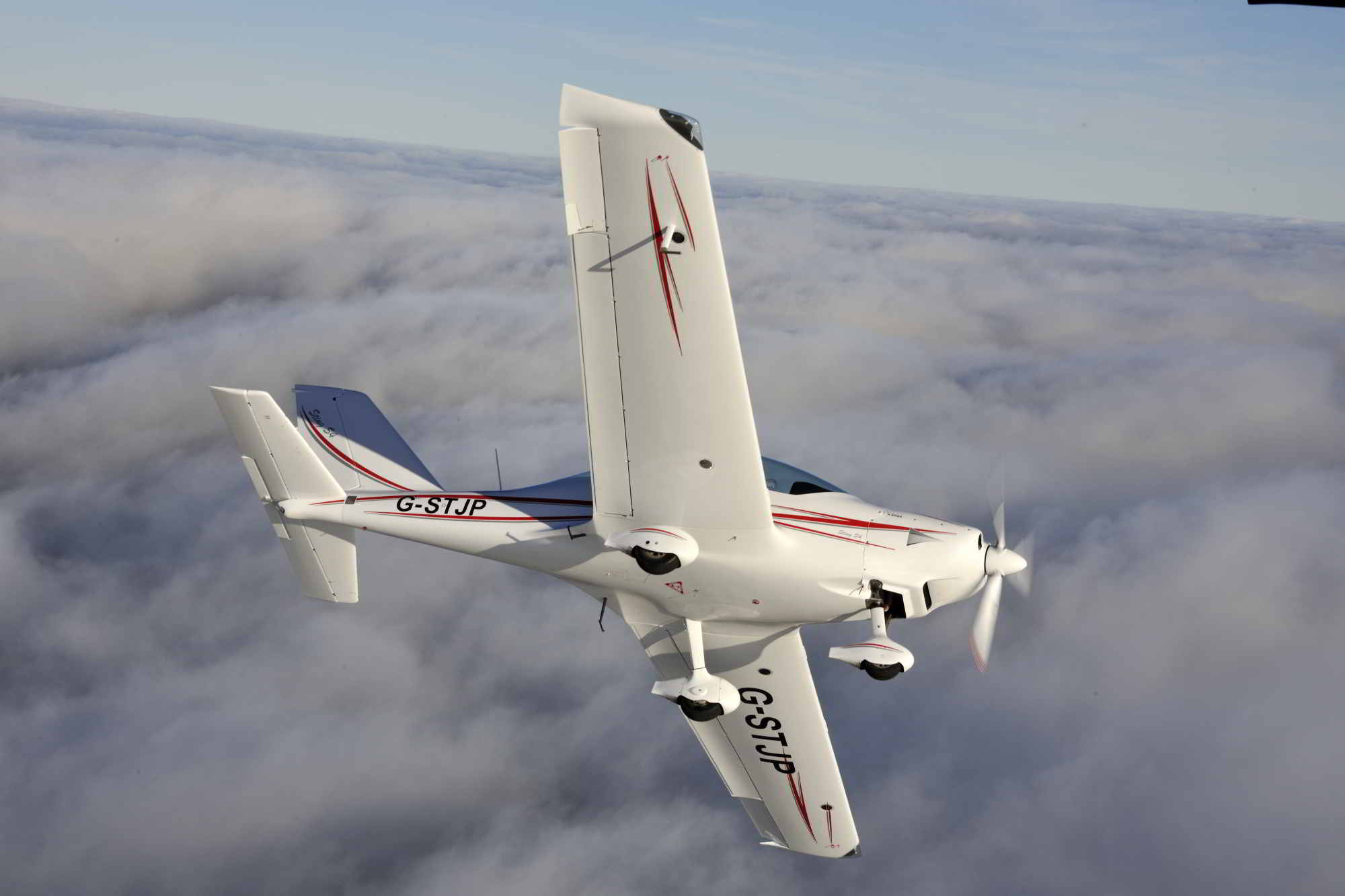
(Keith Wilson photo)
In cruise, the speed tape soon settles on an IAS of 123 knots at 4000 feet, for a TAS of 131 knots and a fuel flow of around 5 gph. Cruising back to Saltby, I briefly examine the cockpit environment. The heater works well—but bafflingly the only vent is on the copilot’s side. It really should have at least two vents and it would be even better if you could get some hot air onto the windscreen as well. Ambient noise levels are low, and would be perfectly acceptable without an ANR headset.
It’s almost agreeable sitting up there in the sunshine, but even with our impressive TAS, we’re barely making 60 knots over the ground, which means the wind at our altitude is 65 knots. It occurs to me that the landing promises to be interesting, and although the wind’s velocity has clearly increased, I sincerely hope its direction has remained the same. Rather reluctantly, I lower the nose and we descend. Beneath the clouds it’s a much drabber world, and rather turbulent, so I decelerate out of the yellow arc to the top of the green at 108 knots.
At 1000 feet, the wind has dropped by 30 knots, giving us a 15-knot net gain, and Saltby slowly comes into view. My first landing is safe but untidy, so for the second I only use the first stage of flaps and make a much steeper approach at 70 knots with the throttle at idle. This works much better, and I must reiterate that it really is very windy—not traditional microlight weather by a long shot!
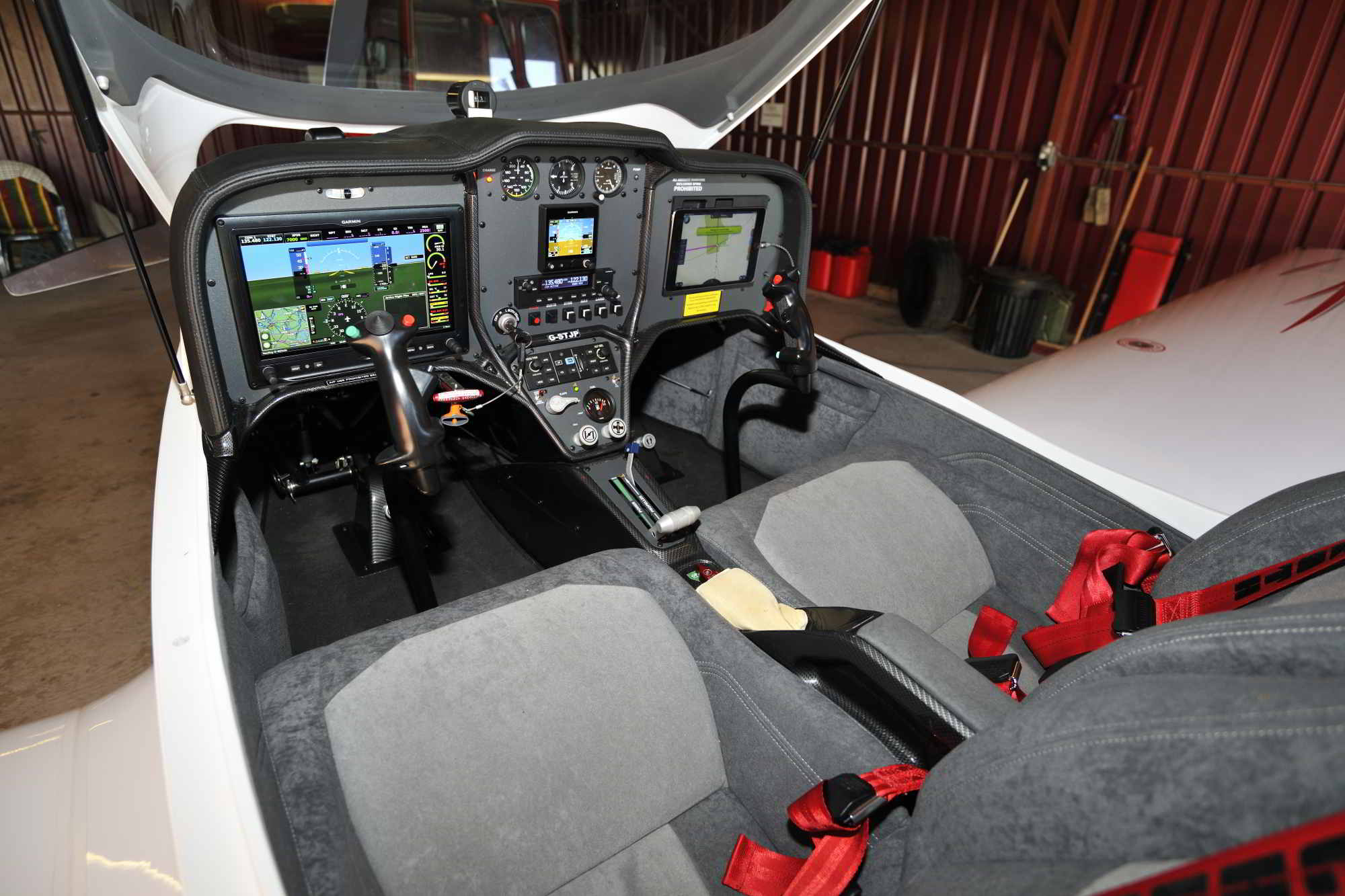
(Keith Wilson photo)
It’s been a great test of the airframe, engine and prop, but John wants me to fully experience and appreciate the advanced avionics, switch-studded stick, touchscreen EFIS and integrated autopilot, and very generously schedules a second flight with Neil Grantham. Neil used to be a training captain for a major airline—and although the TADS describe the Sting as a microlight, that’s only because it weighs 1320 pounds and has a slow stall speed. In many respects this aircraft is way more sophisticated than most traditional GA types, and Neil proves to be the ideal instructor for such advanced systems.
As this is a much less hurried affair, I can take some time to also study the airframe, as well as its systems. The engine is—no surprises—a Rotax 912S, which turns a three-blade constant-speed PowerMax propeller made by TL. The Rotax is fed by a 20-gallon tank mounted in the fuselage, which is in turn fed by two wing tanks with a combined capacity of 11.6 gallons. Each tank has its own filler cap, with the fuselage tank filler in the starboard wing root.
Engine access is excellent, with the top and bottom halves of the cowling secured by Dzus fasteners. The airframe is beautifully made, and drag reduction was obviously at the forefront of the designer’s mind. For example, the aileron Rose joints and pushrods are covered by streamlined fairings. Build quality is very high with the finish comparable to that of a high-performance sailplane.
The spar and all other load bearing structures are constructed from carbon-fiber-reinforced fiberglass (the primary structure is an impressive 85% carbon fiber), while the shell structure of the wing is of foam sandwich construction covered with carbon fiber skins. Unsurprisingly the wing uses a laminar-flow airfoil, but surprisingly there aren’t stall strips. The wing’s trailing edge is slightly swept forward and features ailerons with a relatively short span but a very broad chord and large-span electrically operated split flaps. Aft of the cockpit the rear windscreen incorporates a round frangible panel for the Galaxy ballistic recovery system to fire through, then the fuselage tapers before flaring up into the sweptback fin.
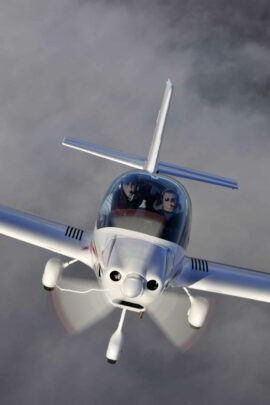
(Keith Wilson photo)
Interestingly, although the Sting seems somewhat dissimilar to its Sirius stablemate, it actually shares considerable component commonality with its high-wing cousin. For example, the undercarriage is basically the same, and the steerable nosewheel strut features a sliding steel tube with an internal spring for shock absorption, while the main wheels are carried by a composite bow.
Continuing the pre-flight inspection, another size-related anomaly is the disproportionally large pitot under the starboard wing, which wouldn’t look out-of-place on a small airliner. I also wondered why it was so far out on the wing. This type of aircraft does a lot of farm strip flying, and in the summer many strips have crops either side of the mown runway, so at times (such as when doing a 180 having backtracked) one of the wings may be over the crop. I’d prefer it if the pitot was just outboard of the port wheel, as that would keep it out of the crop and the propwash.
The cockpit is nicely outfitted, and surprisingly spacious. The instrument panel features a 10in Garmin G3XTouch, an iPad for SkyDemon and a Garmin G5 standby EFIS. The transceiver is also Garmin, a GTR225A, while the GTX335R ADS-B Out transponder is integrated in the G3X, as is the GMC507 Autopilot. ADS-B In is courtesy of a PowerFlarm Eagle.
Apart from the key-type rotary magneto/starter switch, most of the electrical services are operated by push buttons; an excellent design choice in an aircraft where people tend to step down into the cockpit. A centrally located sub-panel links the center consul to the main instrument panel, and it contains a curiosity—two small toggle switches. The red left switch has two positions: up is “auto” and down is “manual.” Basically, with auto set the propeller is in constant-speed mode and controlled with the blue lever. With manual selected, the prop now functions as a variable-pitch prop, controlled by the right switch, up for fine and down for coarse.
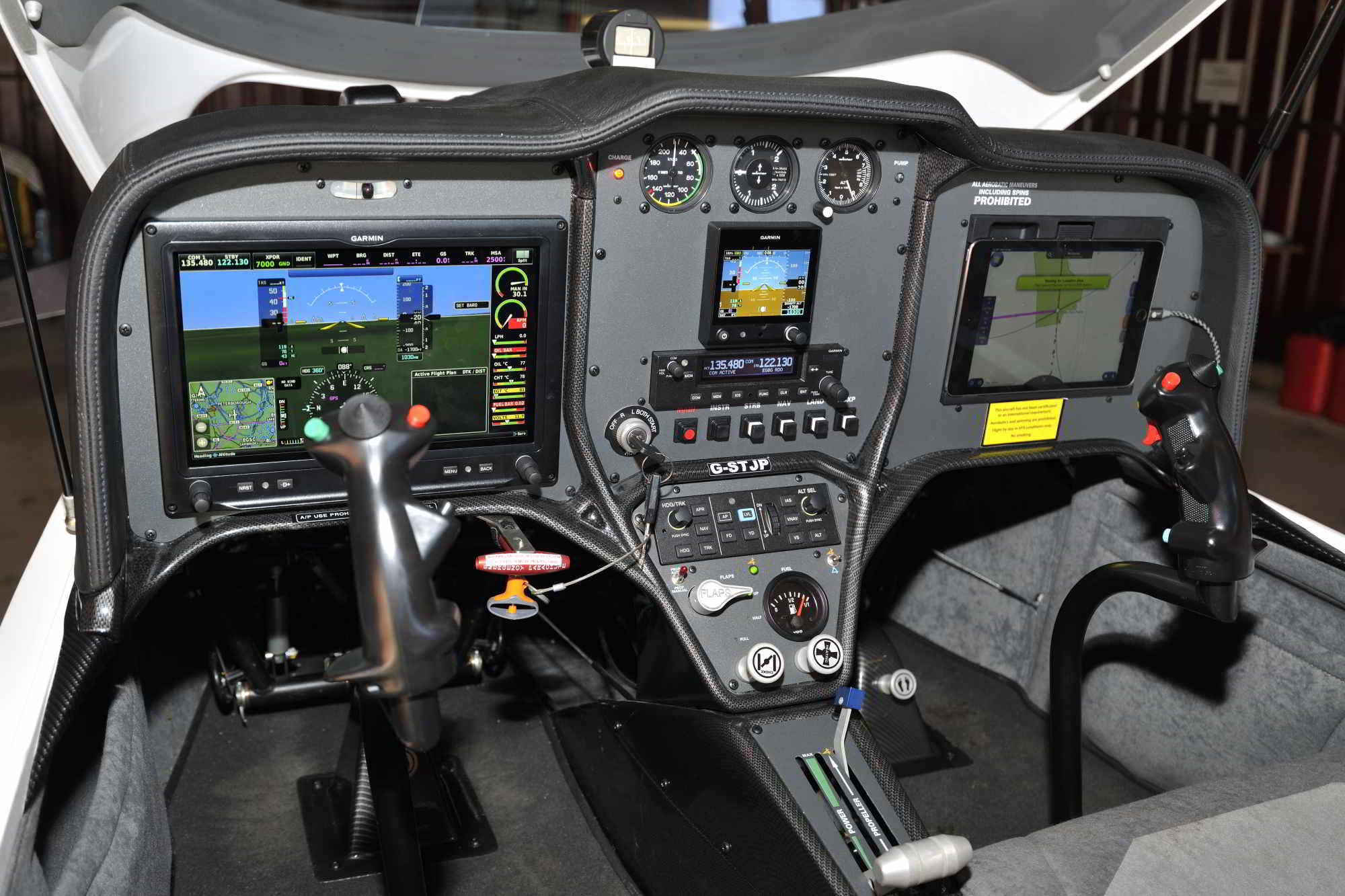
(Keith Wilson photo)
I don’t get it, especially as apart from the rpm changing the only indicator is a green light that comes on when it is fully fine. I bet everyone just leaves it in auto, so what’s the point?
This panel also carries the autopilot control panel, flap selector, fuel gauge and plungers for the choke and cabin heat control. If you’re wondering why—despite the fuel system consisting of three tanks (one in each wing and one in the fuselage) there’s only one gauge, it’s because the wing tanks drain into the fuselage tank, so the gauge always reads full until both wing tanks are empty.
A neat quadrant carries the throttle and prop levers, with the fuel valve between the seats. Similarly, the fuel selector is simply an on/off valve that shuts off the fuel between the fuselage tank and engine. It’s almost a masterclass in cockpit ergonomics, and I was almost relieved to note that the plungers for the choke and cabin heat are practically identical, as it gave me something to complain about. I think the choke should be a different shape and red (same as the fuel valve). This is actually a safety issue—as if you want cabin heat and pull the choke on, the engine could stop. There’s no carb heat, as the carbs are heated by hot coolant.
However, my real beef is with the location of the T-handle for the ballistic parachute release. It’s not only poor, it’s actually dangerous. Take a look at the picture of the cockpit, and you’ll see what I mean. At the very least it should be relocated to the side of the throttle quadrant by the P1’s right thigh.
Back to Flying
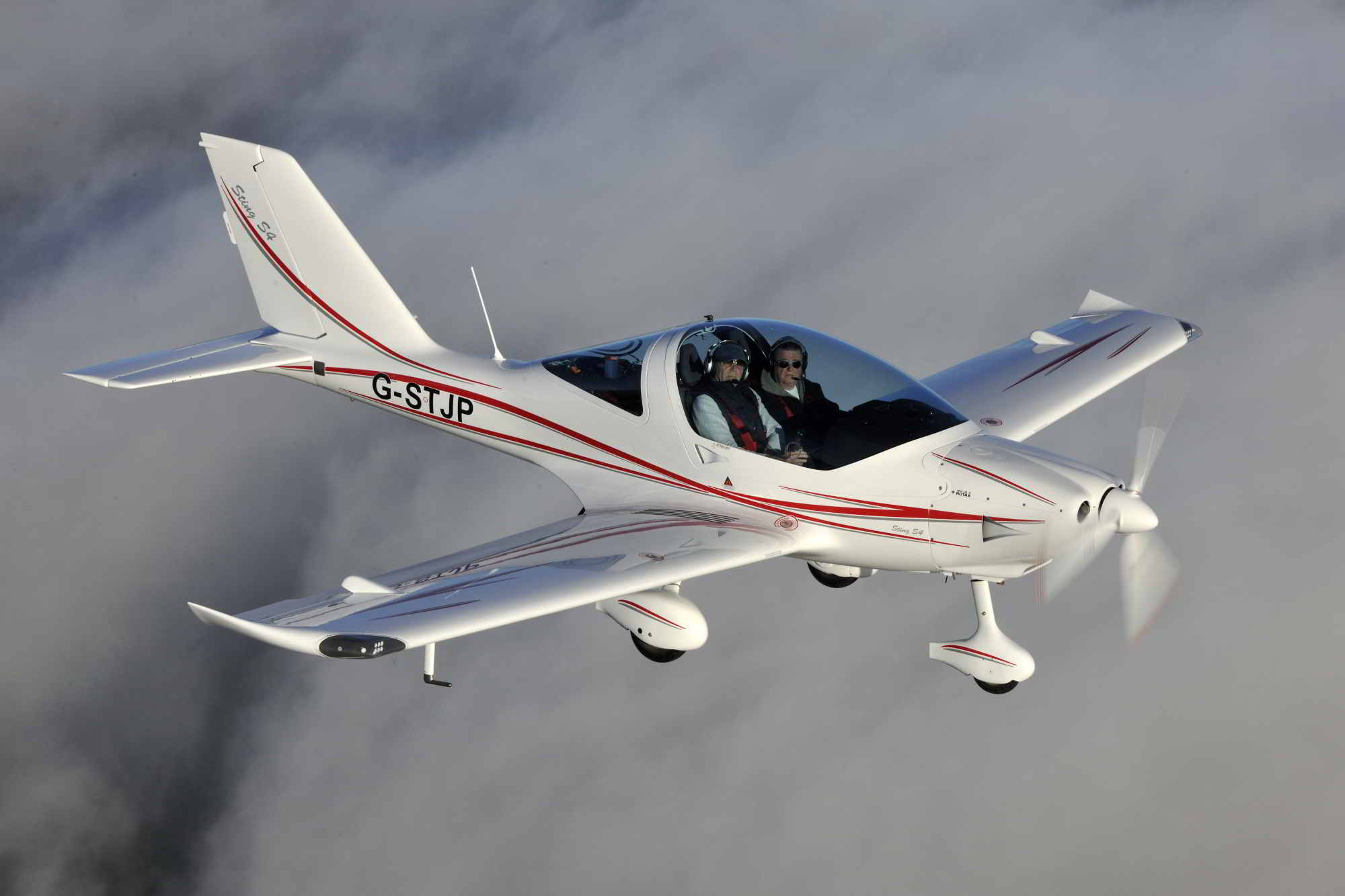
(Keith Wilson photo)
Taxiing is delightfully simple, with a fine view over the nose. The nosewheel steers through the rudder pedals, and if a very tight turn is required differential braking can be applied via the toe-operated hydraulic disc brakes. Many microlight manufacturers install hand brakes as they’re lightweight, easy to make and simple to install, but I like toe brakes—possibly because I have a lot of tailwheel time. Taildraggers are easier if you have good differential braking.
Neil shows me how to load a flight plan into the Flight Management System, and we’re soon launching into a rather gray sky. The object of this flight is to test the avionics, so at 500 feet I engage the autopilot. The autopilot control panel is intuitive, with the lateral (heading and track) functions on the left side and vertical (VNAV) on the right. Of course, there’s no autothrottle, so Neil recommends that I climb using a sensible cruise/climb IAS, but descend using vertical speed mode. The reason is that if you tell it to climb at say 750 fpm, but the engine subtly loses power, it will try and maintain the vertical speed until the wing stalls.
Of course, descending using VS also has a trap—and this is definitely one of those occasions when the throttle needs to be your intention and not your reaction. If you’re zipping along straight-and-level and then select 600 fpm down without adjusting the throttle, you’ll be at Vne before you know it.
Flying with Neil is great. He’s a very patient instructor, and I rapidly begin to appreciate just how sophisticated the systems are, and how they relieve workload. As with all things digital, you must sit down with the book to get the best out of it, but Garmin’s G3X Touch suite is quite intuitive. It’s also extraordinarily powerful, and on more than one occasion I turn to Neil, grin and say: “You sure this thing’s a microlight?”


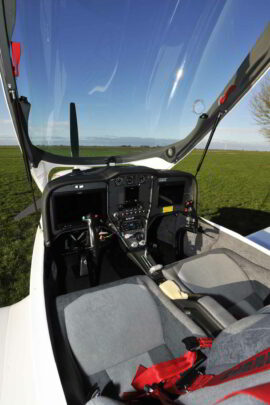
Please give your readers current prices. There is no reason not to. Thanks.
Your interest in price is understandable but to update thousands of article with current prices for airplanes is impossible; it would be all I do.